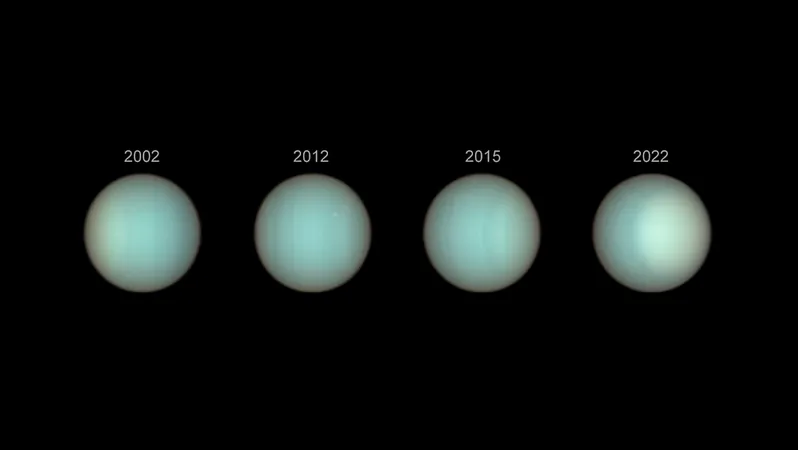
Unveiling the Mysteries of Uranus: Hubble's Groundbreaking Atmospheric Study
2025-04-02
Author: Nur
Introduction
In a fascinating new study that spans two decades, researchers utilizing NASA's Hubble Space Telescope have gained crucial insights into Uranus, one of the most enigmatic planets of our Solar System. This unique ice giant, known for its peculiar sideways rotation, has long been a subject of intrigue. The combination of Hubble’s exceptional resolution and spectral capabilities has allowed scientists to delve deep into Uranus's atmospheric structure and dynamics like never before.
Composition and Methane's Role
These findings mark a significant advancement in our understanding of Uranus's atmosphere, which is predominantly composed of hydrogen and helium, along with methane, water, and ammonia traces. Methane plays a critical role by absorbing red wavelengths of light, giving the planet its distinctive cyan hue.
Research Timeline and Observations
During the course of the study, which spanned from 2002 to 2022, the research team—led by astronomers Erich Karkoschka from the University of Arizona and Larry Sromovsky and Pat Fry from the University of Wisconsin—conducted four observations of Uranus: in 2002, 2012, 2015, and 2022. Unlike its gaseous cousins Jupiter and Saturn, Uranus exhibits a non-uniform distribution of methane, displaying significant depletion near its poles. This peculiar depletion has remained stable over 20 years, while the aerosol and haze structures have dramatically transformed, particularly brightening up in the northern polar region as the planet heads towards its northern summer solstice in 2030.
Seasonal Changes and Atmospheric Dynamics
Uranus takes about 84 Earth years to complete one full orbit around the Sun, meaning the Hubble team has primarily observed seasonal changes leading into northern spring. These observations indicate complex atmospheric circulation patterns, with downwelling phenomena occurring in the polar areas and upwelling in other regions. The analysis reveals not just seasonal variations but also hints at meteorological phenomena that scientists are keen to understand further.
Visual Data and Aerosol Influence
The research includes captivating visual data; the top-row images captured in visible light reveal the colors of Uranus as viewed through a basic telescope, while the subsequent rows present false-color images that illustrate the distribution of methane and aerosols across the planet via assessments from multiple wavelengths of light. This detailed analysis highlights distinct zonal structures concerning aerosol density and methane depletion that had thus far not been properly characterized.
Influence of Solar Radiation
Interestingly, the study also suggests that solar radiation significantly influences the aerosol haze in Uranus’s atmosphere. As the north polar region brightens in the lead-up to summer, the study observes variations in the amount of aerosols present, showcasing an exciting interplay between solar activity and atmospheric composition.
Future Observations and Significance
With Uranus's transportation along its elongated orbit summarizing nearly half a human lifetime, the upcoming years will be critical for researchers. Astronomers plan to continue their observations as Uranus approaches its northern summer, hoping to unlock more secrets of its captivating atmosphere.
Conclusion
The Hubble Space Telescope continues to revolutionize our understanding of the cosmos, with its findings offering valuable insights not only for our Solar System but also for distant exoplanets with similar characteristics. As we look forward to more revelations, Hubble remains a symbol of international collaboration and exploration between NASA and the European Space Agency (ESA). Its continued operation at NASA’s Goddard Space Flight Center highlights the enduring importance of space exploration in addressing the fundamental questions of our universe.
Stay tuned as we await further discoveries that could reshape our view of Uranus and beyond!

 Brasil (PT)
Brasil (PT)
 Canada (EN)
Canada (EN)
 Chile (ES)
Chile (ES)
 Česko (CS)
Česko (CS)
 대한민국 (KO)
대한민국 (KO)
 España (ES)
España (ES)
 France (FR)
France (FR)
 Hong Kong (EN)
Hong Kong (EN)
 Italia (IT)
Italia (IT)
 日本 (JA)
日本 (JA)
 Magyarország (HU)
Magyarország (HU)
 Norge (NO)
Norge (NO)
 Polska (PL)
Polska (PL)
 Schweiz (DE)
Schweiz (DE)
 Singapore (EN)
Singapore (EN)
 Sverige (SV)
Sverige (SV)
 Suomi (FI)
Suomi (FI)
 Türkiye (TR)
Türkiye (TR)
 الإمارات العربية المتحدة (AR)
الإمارات العربية المتحدة (AR)